Moments later I have to slow for traffic, and my chance to feel the Triumph bashing up against its rev limiter in top gear--as it was about to do--is gone, and gone for good. Daytona's streets are clogged with bikes and police, and I don't need to be reminded that the last time I rode a turbo-bike here it cost me $250 after being speed-trapped at just over 100 mph. And the world's first Rocket III turbo has the horsepower to be a whole lot more expensive than the Bonneville I was riding then.
The Hinckley-built triple is seriously fast in stock form and has sold quite well since its introduction two years ago. But some were disappointed its massive, 2294cc triple was tuned more for flexibility than balls-out performance. The Rocket makes a respectable 132 rear-wheel horsepower and a whopping 141 pound-feet of torque, but it isn't half as scary as it looks. Some might say it looks a bit tame.
Bolting on a turbo from Turbo Connection changes all that. Running just 8 psi of boost on standard pump gas, this Rocket III routes 202.8 horses to its rear tire along with 215 pound-feet of torque. Turbo Connection boss Brian Olson can't help grinning when he talks about the bike, which was like a Hinckley factory gift to someone specializing in turbocharged Triumphs. "It's just a beautiful turbo motor," says the man from Rapid City, South Dakota. "As well as its size and three-cylinder smoothness, it has low compression, just 8.7:1, which is what you want [when turbocharging], and a strong bottom end. It even has twin plugs per cylinder, which helps combustion. As soon as I saw it I knew it would be ideal [for a turbo]."
Olson should know. He's a 33-year-old motorcyclist and engineer who began turbocharging cars in the late 1980s, progressed to 200-horsepower turbo snowmobiles and then concentrated on Triumph triples after founding Turbo Connection in 1992. His blown Speed Triples and Sprint STs have been producing a Hayabusa-beating 160 bhp for years, but the Rocket III offers a dramatically different level of performance.
Olson says developing the Rocket kit was relatively straightforward. The turbo is from New York-based iBoost, formerly Aerocharger. The unit differs from many turbos because it's a variable-vane unit, meaning boost is controlled not by a wastegate but by adjusting the position of the turbo's vanes. For more boost they're closed up; for less they're opened slightly to allow more exhaust gas to escape straight into the exhaust.
Olson fitted the compact turbo beneath the huge engine, where it's barely visible at first glance. His kit includes everything needed to get the bike running with "about a day's work for a typical owner," according to Olson. Besides the unit itself there's a special aluminum airbox, a stainless steel exhaust system and a boost computer to monitor the fuel-injection system.
The Triumph's burly bottom end, lightly stressed in stock form, is more than capable of handling the extra performance, Olson says. His only strengthening mod is to fit stiffer clutch springs, included in the kit. Even so, lever action is surprisingly light as I climb aboard and press the starter button, setting the motor alight with a slightly high idle and a deep and very loud burble from the slash-cut silencer.
If my first impression is of how docile and normal the turbo-Rocket feels as I maneuver it from a parking lot out onto the street, the second is exactly the opposite--because this bike is just crazy fast.
From a walking pace in first gear, a crack of the throttle has the front wheel leaping into the air in a way no long-wheelbase, 803-pound motorcycle has a right to. This bike is way quicker off the mark than the standard Rocket, itself one of the world's hardest-launching street-legal motorcycles.
Equally impressive, the engine doesn't suffer from turbo-lag. The iBoost's design, doubtless helped by Olson's plumbing experience, has virtually eliminated lag. Boost is always available to send the bike rocketing forward at the touch of the throttle.That awesome, 200-plus peak horsepower is produced at 5500 rpm, with maximum torque arriving at just 3750. Those numbers come at higher points on the scale than the standard Rocket's peak numbers, but the blown bike's curve is far higher along the chart from just off idle all the way to the 6500-rpm rev limit.
And it certainly feels that way. From almost any engine speed, hard acceleration results in a riot of blurred scenery and frantic gear-changing to avoid running out of revs. The roar from the slash-cut pipe makes it feel even faster. The drainpipe-like, 90mm-diameter tailpipe comes standard with the kit, but Olson offers a quieter unit if requested.
This black bike's flyscreen and stepped Corbin seat aren't included in the kit, but I was glad of the way they kept me aboard as the Rocket demolished every vehicle it encountered on the straight roads in and around Daytona. Having the aerodynamics of a small building doesn't matter when you've got this much power at the end of the cable.
Olson left the Triumph's chassis standard, which isn't a problem. The Rocket stays plenty stable under ultra-hard acceleration, even while cranked over on the few fast corners I find. Thankfully, the bike's triple-disc brakes aren't fazed by all that speed and weight. And the fat rear Metzeler does a pretty good job of putting power to the ground. Rubber and fuel costs would be considerable if this bike was used as its maker intends. But at least the kit's $5395 price is reasonable.
My test ride was relatively short, which is probably just as well given this bike's performance and my previous dealings with the Florida Highway Patrol. But the memory of the Turbo Rocket will linger long.
Turbo Connection's Harley-Davidson V-Rod will evoke similar, long-lasting memories, but for slightly different reasons.
Ever wonder how many Harley-Davidsons there are at Daytona Beach Bike Week? Tens of thousands, probably. Hundreds of thousands, according to some. So, rumbling along Speedway Boulevard on what is perhaps the fastest, most powerful street-legal Harley in all of Florida feels pretty good.
Especially when I jack the throttle open on a lightly trafficked back road and the Harley doesn't hesitate. Its relaxed exhaust note becomes a snarl, and the bike leaps forward with near shoulder-splitting force, its acceleration sending me storming past other vehicles and onto the open road, eyes watering behind my shades and a big, nasty grin on my face.
When I back off to shift there's a high-pitched sound from somewhere near my right boot, but I don't need that to tell me this bike is special--its ferocity does so well enough. Within seconds I'm approaching an indicated 140 mph in top gear, the V-Rod still pulling hard until another car looms up ahead to slow me down.
The standard V-Rod is quick thanks to its 1130cc, liquid-cooled, dohc eight-valve engine. But Turbo Connection's version is far quicker. On the lower of its two boost settings the V-Rod puts 156 horsepower through its back tire--nearly as much as the standard V-Rod's 107-horse output on the same dyno.
Running high-octane fuel gives even more performance at the flick of a switch. Selecting the high-boost setting using the switch located to the left of the fuel tank bumps maximum boost from 7 to 9 psi and increases peak output to 170 bhp at 9000 rpm. Yes, you read that right--one hundred seventy horsepower from a street-legal and very rideable Harley-Davidson.
Turbocharging can do that for an engine, as Olson is fond of demonstrating. Although he's concentrated on Triumphs since starting Turbo Connection in '92, he couldn't resist doing a V-Rod, which turned out very different from his Rocket III project. That bike is a sleeper, its turbo tucked away unobtrusively beneath the huge engine. The V-Rod's tightly packaged, lower-slung lump left no room for a similar approach.
Besides, the Harley rider's unofficial motto is, "If you've got it, flaunt it." So hanging proudly off the V-Rod engine's right side, breathing through a big filter and plumbed in with chrome-covered tubing is another iBoost turbocharger. Several years ago, Aerocharger produced its own very effective turbo kit for Harley's air-cooled V-twins, despite conventional wisdom that says turbocharging works best for multicylinder engines because twins, with their relatively infrequent and irregular power pulses, are more susceptible to turbo lag.
Lag occurs because a turbocharger has to spin very fast (100,000-rpm-plus) to deliver useful boost. At low-rpm throttle openings a conventional turbo spins slowly because most of the exhaust gas is diverted past it by the wastegate. So when the throttle is opened there's a delay before full operating speed is reached. The iBoost turbo's variable vanes, however, restrict the exhaust inlet when the throttle is partly open, so some boost is generated whenever the motor's running, and the time taken to reach full boost is much shorter.
"Lag? There is no lag," says a grinning Olson, and he's basically right. The kit was reasonably easy to develop, he says. As well as the turbo unit, it includes a plug-in computer to modify the injection system, a stainless steel exhaust with a SuperTrapp muffler and a neat combined intercooler and airbox that sits under the dummy tank."The V-Rod has relatively high compression [11.3:1], so you need a cool charge going into the engine," Olson says. "That's why the intercooler's necessary on this bike and not on the Rocket III. My aim is to make kits easy to fit and run reliably without needing any major work. The V-Rod is a very strong motor that's well suited to turbocharging." Another advantage of the iBoost's design is that the turbo is lubricated by its own self-contained system of specially formulated oil instead of relying on engine oil as a conventional turbo does.
Stiffer clutch springs mean a little extra effort is required at the lever, but in other respects the turbo V-Rod is as easy to ride as a stocker. And any inconvenience is quickly forgiven every time I wind back the throttle, which sends the V-Rod leaping forward like no other Harley I've ever ridden. Top speed is limited by gearing and neck strength rather than horsepower.
But it's the turbo 'Rod's extra midrange stomp that really impresses. The standard V-Rod engine is relatively peaky for a twin, with a torque curve that dips notably at 5000 rpm before rising toward its 72.4-pound-feet maximum at 7500 rpm. By contrast, the turbo-motor's curve peaks 2000 rpm earlier at no less than 121.6 pound-feet (108.8 pound-feet on the low boost setting), so the Turbo Connection bike is putting out 68 percent more torque at that point.
What that means out on the asphalt is that cracking open a standard V-Rod's throttle at about five grand results in not a whole lot of forward oomph, but doing so on this bike produces a reaction strong enough to bring the Daytona Beach tide in early. It also makes for effortless, instantaneous passing. And the V-Rod's robust chassis and strong brakes are quite capable of coping with the extra speed.
For such an outrageous performance mod, the turbo kit is surprisingly practical, too. And the Turbo Connection kit's price looks like an even better value when you consider more traditional, labor-intensive tuning alternatives. It's difficult to think of a simpler, more effective way to bolt serious horsepower onto a Harley--or of a more appealing method of ending up with one of the hardest-accelerating bikes in Daytona. MC












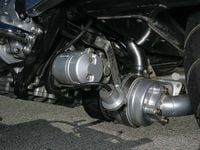
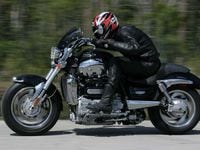
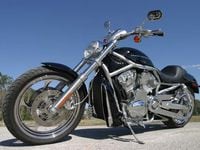
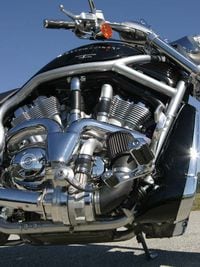



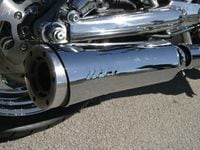
/cloudfront-us-east-1.images.arcpublishing.com/octane/ITNLTIU5QZARHO733XP4EBTNVE.jpg)
/cloudfront-us-east-1.images.arcpublishing.com/octane/VZZXJQ6U3FESFPZCBVXKFSUG4A.jpg)
/cloudfront-us-east-1.images.arcpublishing.com/octane/QCZEPHQAMRHZPLHTDJBIJVWL3M.jpg)
/cloudfront-us-east-1.images.arcpublishing.com/octane/HXOUJXQWA5HBHGRO3EMJIGFMVI.jpg)

/cloudfront-us-east-1.images.arcpublishing.com/octane/3TIWWRV4JBBOLDVGRYECVVTA7Y.jpg)
/cloudfront-us-east-1.images.arcpublishing.com/octane/KIX5O23D5NAIBGFXBN3327DKZU.jpg)
/cloudfront-us-east-1.images.arcpublishing.com/octane/7GJYDUIPXRGMTMQKN6ONYOLBOU.jpg)
/cloudfront-us-east-1.images.arcpublishing.com/octane/MUQLOVLL2ZDGFH25ILABNBXKTI.jpg)
/cloudfront-us-east-1.images.arcpublishing.com/octane/TNOU5DNE2BC57MFPMGN2EIDXAM.jpg)
/cloudfront-us-east-1.images.arcpublishing.com/octane/GTCXACQGJ5HAPDTGWUQKDEH44E.jpg)
/cloudfront-us-east-1.images.arcpublishing.com/octane/S35YGSEMEZB4BLTDJTSZPF4GLA.jpg)
/cloudfront-us-east-1.images.arcpublishing.com/octane/5UOT6HPX2JFMRJAX6EH45AR4MQ.jpg)
/cloudfront-us-east-1.images.arcpublishing.com/octane/OKWOJWAKP5EP3OACCRRWPCIX2Q.jpg)
/cloudfront-us-east-1.images.arcpublishing.com/octane/2WF3SCE3NFBQXLDNJM7KMXA45E.jpg)
/cloudfront-us-east-1.images.arcpublishing.com/octane/G4MG6OUCJNBSHIS2MVVOTPX65E.jpg)
/cloudfront-us-east-1.images.arcpublishing.com/octane/IIGGWFOTOJGB7DB6DGBXCCMTDY.jpg)
/cloudfront-us-east-1.images.arcpublishing.com/octane/QSTCM6AVEZA5JJBUXNIQ3DSOF4.jpg)
/cloudfront-us-east-1.images.arcpublishing.com/octane/U4I7G625B5DMLF2DVIJDFZVV6M.jpg)
/cloudfront-us-east-1.images.arcpublishing.com/octane/B6XD6LS6IVCQPIU6HXDJSM3FHY.jpg)
/cloudfront-us-east-1.images.arcpublishing.com/octane/ICL63FEDDRDTTMINYICCEYGMDA.jpg)
/cloudfront-us-east-1.images.arcpublishing.com/octane/FCGZHQXRBZFLBAPC5SDIQLVF4I.jpg)
/cloudfront-us-east-1.images.arcpublishing.com/octane/WNOB6LDOIFFHJKPSVIWDYUGOPM.jpg)
